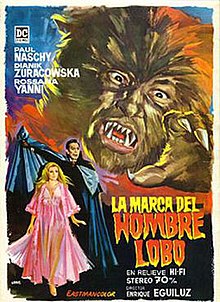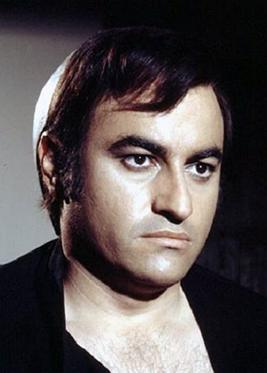
Jacinto Molina Álvarez known by his stage name Paul Naschy, was a Spanish film actor, screenwriter, and director working primarily in horror films. His portrayals of numerous classic horror figures—The Wolfman, Frankenstein's monster, Count Dracula, Quasimodo, Fu Manchu and a mummy—earned him recognition as the Spanish Lon Chaney. Naschy also starred in dozens of action films, historical dramas, crime films, TV shows and documentaries. He also wrote the screenplays for most of his films and directed a number of them as well, signing many of them "Jacinto Molina". Naschy was bestowed Spain's Gold Medal of Merit in the Fine Arts in 2001.
León Klimovsky Dulfán was an Argentine film director, screenwriter and producer notable for his work during the classical era of Argentine cinema. He was known mainly for his work in Spanish cinema during the 1960s and '70s.

Commander USA's Groovie Movies is an American movie showcase series that ran weekend afternoons on the USA Network.

La Noche de Walpurgis /Walpurgis Night, is a 1970 Spanish/German horror film starring Paul Naschy, the fifth in his series about the werewolf Waldemar Daninsky. This film was directed by León Klimovsky and written by Paul Naschy, and is generally regarded to have kickstarted the Spanish horror film boom of the 1970s. This was Naschy's all-time most financially successful film. It was also the first of 8 films that he would make with director Leon Klimovsky at the helm.
Las Noches del Hombre Lobo is a lost 1968 Spanish horror film that centers around the werewolf Count Waldemar Daninsky, played by Paul Naschy. It has been credited as the second part of Paul Naschy's 12 "Hombre Lobo" films. However, it's been heavily disputed if the film was ever made or exists at all. No one, including Naschy himself, has ever viewed the film and it has never seen a theatrical or home media release.

Los Monstruos del Terror, also known as Dracula vs. Frankenstein and Assignment: Terror, is a 1970 Spanish-West German-Italian horror and Sci-Fi film co-directed by Tulio Demicheli and Hugo Fregonese.. Eberhard Meichsner was also credited as a director only in the British promotional material, but by all accounts he was not actually involved.

The Fury of the Wolfman, aka Wolfman Never Sleeps, is a 1970 Spanish horror film that is the fourth in a long series about the werewolf Count Waldemar Daninsky, played by Paul Naschy. Naschy wrote the screenplay as well. The film was shot in early 1970. It was not theatrically released in Spain until 1975 due to problems involved in finding a distributor, although it was distributed in edited form on U.S. TV in 1974.

Dr. Jekyll y el Hombre Lobo, also known as Dr. Jekyll and the Werewolf, is a 1971 Spanish horror film, the sixth in a series of 12 films about the werewolf Count Waldemar Daninsky, played by Paul Naschy. Naschy actually plays a triple role in the film, portraying Waldemar Daninsky, the Wolf Man and Mr. Hyde. This was Naschy's 2nd film working with director Leon Klimovsky, following their hugely successful 1970 collaboration La Noche de Walpurgis. This film also featured Euro-Horror star Jack Taylor, Mirta Miller and the beautiful Shirley Corrigan of England. The film failed however to reach the box office success of Walpurgis.

El Retorno de Walpurgis is a 1973 Mexican-Spanish co-production horror film that is the seventh in a twelve-film series about the werewolf Count Waldemar Daninsky, played by Paul Naschy. This film ignored the events in all of the earlier Wolf Man films and began an entirely new origin for el Hombre Lobo, which is strange because the film's Spanish title The Return of Walpurgis seems to tie it in with Naschy's earlier 1970 film Walpurgis Night. The Wolf Man makeup was done by Fernando Florido. The film was shot in June 1973, and by September, it was already in theaters in Spain, as El Retorno de Walpurgis. It wasn't released theatrically in the U.S. however until 1976, as Curse of the Devil.
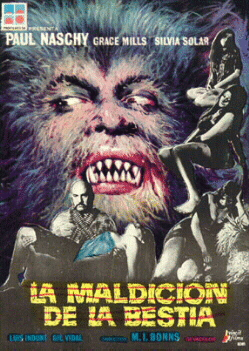
La Maldicion de la Bestia is a 1975 Spanish horror film that is the eighth in a long series about the werewolf Count Waldemar Daninsky, played by Paul Naschy. The film has also been known as The Werewolf and the Yeti, Night of the Howling Beast and Hall of the Mountain King. This film ignored the events from the earlier Hombre Lobo films and provided an all-new origin for Waldemar's lycanthropy, having the curse transmitted to Waldemar by the bites of two female werewolves. A yeti is woven into the storyline, but in this film the Yeti is not the direct cause of Waldemar's lycanthropy. Fernando Florido and Adolfo Ponte handled the special effects throughout the film.

El Retorno del Hombre Lobo is a 1980 Spanish horror film that is the ninth in a 12-film series about the werewolf Count Waldemar Daninsky, played by Paul Naschy. It is also known as The Craving and Night of the Werewolf.
The Beast and the Magic Sword is a 1983 Spanish/Japanese horror film that is the tenth in a long series of films about the werewolf Count Waldemar Daninsky, played by Paul Naschy. This film moved the Daninsky family curse back to a medieval setting, as Naschy felt the Daninsky saga need not always be confined to a modern-day setting.
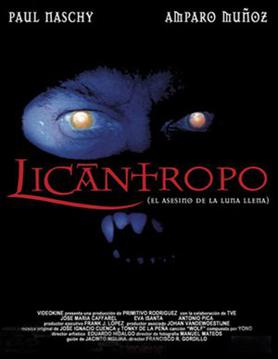
Licántropo, also known as Licantropo: The Moonlight Murders or Lycanthrope: The Full Moon Killer, is a 1996 Spanish horror film that is the 11th in the "Hombre Lobo" series about the werewolf Count Waldemar Daninsky, played by Paul Naschy. Following his near-fatal heart attack in 1991, Naschy wrote the screenplay for this film as a sort of therapy while he was recuperating from his surgery. He filed it away for future use and the script lay dormant until producer Primitivo Rodriguez contacted Naschy in 1996 and asked him if he had any ideas for a new horror movie.
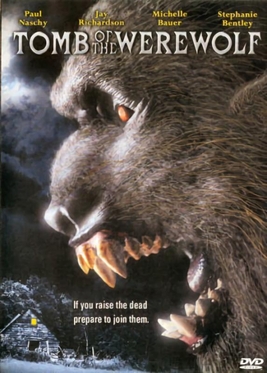
Tomb of the Werewolf is a 2003 film directed by Fred Olen Ray. It is the twelfth and last in a long series of films about the werewolf Count Waldemar Daninsky, played by Paul Naschy. The film contains a number of adult sex scenes bordering on softcore pornography. The film was shot on Video in 2003 and first distributed directly to VHS as Tomb of the Werewolf in June 2004. It was later reissued as an uncensored DVD in 2015 as The Unliving by Retromedia Entertainment. Director Ray said years later in an interview that the film never made a profit.

Vengeance of the Zombies is a 1972 Spanish horror film directed by León Klimovsky and starring Paul Naschy, Mirta Miller, Vic Winner and Aurora de Alba. The film was shot in July 1972, but was only theatrically released in Spain in June 1973. It was shown in Italy as La Vendetta dei Morti Viventi. The film was shown in Germany over the years under three different titles....Rebellion of the Living Dead, Invocation of the Devil and Blood Lust of the Zombies.

La orgía de los muertos a.k.a. The Hanging Woman, Beyond the Living Dead, Return of the Zombies and Bracula: Terror of the Living Dead, is a 1972 Spanish/ Italian horror film directed by José Luis Merino, starring Paul Naschy and Dyanik Zurakowska. The film was shot in March 1972, but wasn't shown in Spanish theaters until September 3, 1973. It was shown theatrically in the U.S. in 1974 as The Hanging Woman, and then was later re-released there as Beyond the Living Dead. It was released in Germany on April 6, 1976 as Der Totenchor der Knochenmanner/ Death Chorus of the Skeletons, and re-released in Germany on March 1, 1977 as Die Bestie aus dem Totenreich/ The Beast from the Death Realm. It was shown in the U.K. as Zombies - Terror of the Living Dead, in France as Les Orgies Macabres, and in Australia as Bracula, Terror of the Living Dead.
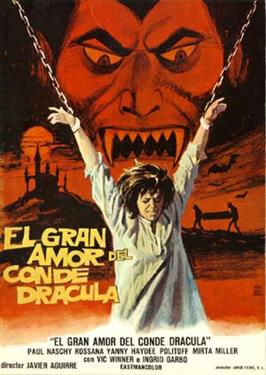
Count Dracula's Great Love is a 1973 Spanish film directed by Javier Aguirre, and starring Paul Naschy as Count Dracula. The film also features Rosanna Yanni, Haydee Politoff, Mirta Miller and Ingrid Garbo.
Marta Susana Yanni Paxot, best known as Rosanna Yanni or Rossana Yanni, is an Argentine film actress.
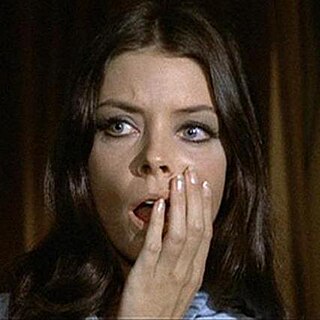
Patricia Moran Shepard was an American film actress based in Madrid, Spain. She appeared in more than fifty Spanish, Italian and French films from the 1960s to the 1980s, notably several cult horror films.
Inquisition is a 1976 Spanish-Italian historical horror film written and directed by Paul Naschy. It also features Daniela Giordano, Julia Saly and Mónica Randall. The film was shot in May and June 1976, and first shown in Spain in 1978. The special effects were handled by Fernando Florido, who outdid himself with his elaborate design for the demon Belphegor, seen during the film's bizarre dream sequence. Daniela Giordano loved the film and thought it was one of the best projects she ever worked on. An Argentinian one-sheet exists with the name of the film as Bajo el terror de la Inquisicion / Under the Terror of the Inquisition, but there is no evidence that the film was ever shown there theatrically.
